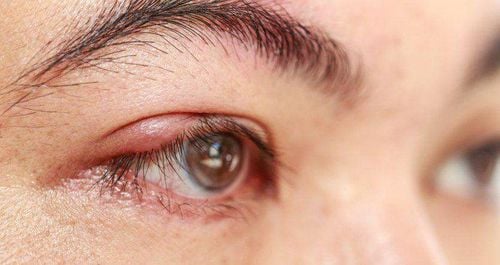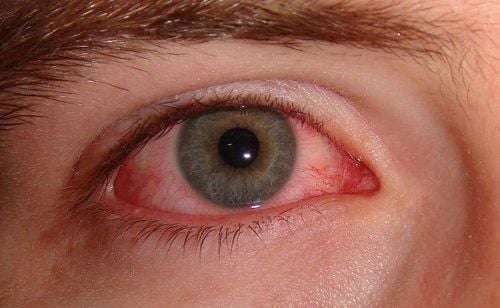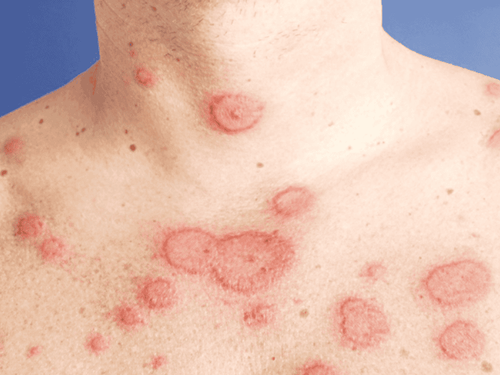This is an automatically translated article.
Lupus erythematosus is a chronic autoimmune disease that can affect any part of the body including the eyes. The course of the disease is unpredictable and is characterized by periods of flare-ups and periods of remission, which can be acute or chronic.
1. Lupus erythematosus
Lupus erythematosus is a chronic autoimmune disease that often affects the skin, joints, blood vessels, heart, kidneys, and nervous system. The disease can also affect the eyes. Normally, the body's immune system will fight against foreign invaders such as bacteria and viruses. However, in patients with lupus erythematosus, the immune system works abnormally, attacking healthy tissues in the body.
2. Effects of lupus erythematosus on the eyes
Patients with lupus erythematosus often have periods of severe disease, followed by periods of remission. During a flare-up, inflammation and swelling occur in the body, creating fatigue, pain, and tissue damage. The eyes are also the target of the disease.
Thời gian bệnh bùng phát gây nhiều đau đớn cho người bệnh
2.1 Dry eye disease Dry eyes seem to occur frequently in people with autoimmune diseases such as lupus erythematosus. However, patients with lupus erythematosus may develop dry eye disease, also known as dry eye syndrome.
Dry eye syndrome is a condition in which the symptoms of dry eye become quite severe, often producing an unpleasant sensation of sand in the eye as well as an itching and burning sensation in the eye. The amount of tears is significantly reduced, affecting the outer parts of the eye such as the cornea and conjunctiva.
If dry eye syndrome occurs with arthritis and a feeling of dry mouth, it is called Sjogren's syndrome. This syndrome is more common in people with autoimmune arthritis as well as lupus erythematosus. About 20% of patients with lupus erythematosus have this syndrome. Dry eyes occur because the tear glands do not produce enough tears to nourish and lubricate the eyes.
Dry eye can progress to damage the anterior surface of the eye and cause visual impairment. Dry eye caused by lupus erythematosus is difficult to distinguish from other dry eye conditions.
2.2 Eyelid disease The eyelids can also become irritated in people with autoimmune diseases. Patients with lupus erythematosus may develop an uncomfortable skin condition that appears as a thick rash on the eyelids. Occasionally the patient may experience burning and itching. Scarring lesions can cause deformity along the edge of the eyelid.

Bệnh lupus cũng có thể lây lan và phát ban dày lên mí mắt
The rash is made up of small scaly or disc-shaped lesions. The rash mainly appears on sun-exposed areas. Exposure to secondhand smoke may also play a role in the development of this condition.
Approximately 10% of patients with lupus erythematosus may experience this condition. These lesions usually respond well to treatment with oral steroids.
2.3. Retinopathy Retinal vasculitis is a complication of lupus erythematosus, in which the blood supply to the retina is reduced or limited. The retina then tries to repair itself by growing new blood vessels, a process known as neovascularization. Unfortunately, these new blood vessels are fragile and weak. Blood and fluid tend to leak out of the new blood vessel causing swelling in the retina.
When retinal vasculitis involves the macula, the patient's central vision may be reduced or lost. Vasculitis can also affect the optic nerve and eye muscles.
The doctor may also observe “cotton spots” in the patient's retina. Cotton spots are small, white areas of the retina that swell due to lack of blood flow and oxygen to the area.
2.4. Scleroderma Lupus erythematosus can cause scleritis. The sclera is the hard, white outer covering of the eyeball. Scleritis causes the sclera to become inflamed and painful.
Due to inflammation, the sclera becomes thinner, creating a very weak eye area that can be punctured or increase the risk of serious damage if there is an eye injury in the future.

Lupus ban đỏ có thể khiến cho lớp màng cứng bị viêm đau
For most patients, scleritis primarily causes pain, sensitivity to light, blurred vision, and redness or dark patches on the sclera.
Scleritis can be treated with steroids and with topical or non-steroidal anti-inflammatory drugs. The best way is when you notice abnormalities in your eyes, you should see an ophthalmologist immediately.
2. 5. Ocular neuropathy Although uncommon, some lupus patients develop optic neuritis. This is an inflammation of the covering around the optic nerve. Usually only one eye is affected with optic neuritis, but profound vision damage can occur. Optic neuritis associated with lupus erythematosus often causes the optic nerve to atrophy.
Optic neuropathy can also occur when the blood vessels supplying the optic nerve are blocked, causing a stroke-like condition in the eye. This is a very serious condition that requires prompt treatment, otherwise the eyes can be severely damaged.
Lupus optic neuropathy occurs in one in two people with lupus erythematosus. Vision loss progresses slowly, sometimes vision loss is more rapid.
Cranial nerve paralysis can lead to double vision, poor eye movement and alignment, poor pupillary reflex, and drooping eyelids.
Damage to the optic nerve fibers in the brain can cause hallucinations and loss of peripheral and/or central vision.

Bệnh thần kinh thị giác do lupus khiến cho thị lực bị suy giảm nghiêm trọng
Eye lesions in patients with lupus erythematosus can be caused by the disease itself, or it can also be a side effect of some drugs used to treat the disease. Hydroxychloroquine (Plaquenil) in particular can cause retinal toxicity over time, especially when used in high doses.
Doctors recommend that lupus patients have a comprehensive eye exam every year. In particular, patients treated with Hydroxychloroquine should have a baseline eye exam before starting the drug and a routine yearly checkup.
Vinmec International General Hospital with a system of modern facilities, medical equipment and a team of experts and doctors with many years of experience in medical examination and treatment, patients can rest assured to visit. examination and treatment at the Hospital.
To register for examination and treatment at Vinmec International General Hospital, you can contact Vinmec Health System nationwide, or register online HERE.
References: lupus.org, verywellhealth.com, webmd.com













